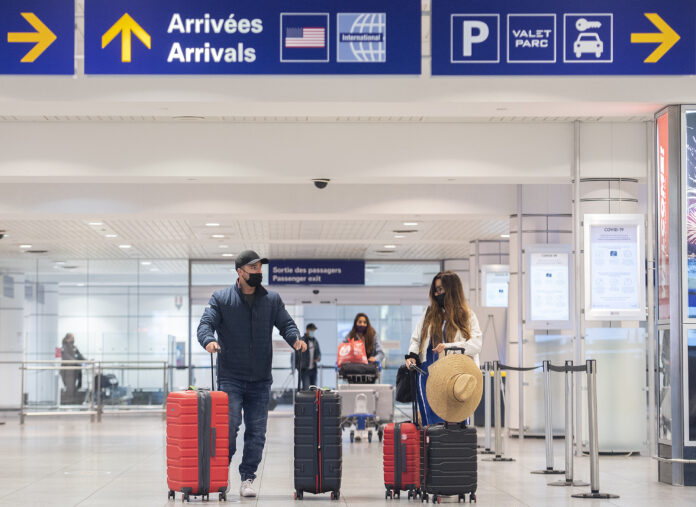Canada’s border rules are changing again as the country enters a warming spring season with restrictions easing across the nation.
On Monday, Ottawa lifted several measures related to travel with many Canadians seeking trips abroad for potentially the first time since the COVID-19 pandemic began in early 2020.
Here’s what you need to know.
As of 12:01 a.m. ET, unvaccinated and partially vaccinated kids ages five to 11 accompanied by a fully vaccinated parent, step-parent, guardian or tutor no longer need to complete a pre-entry COVID-19 test to enter Canada.
However, pre-entry tests are required for partially vaccinated or unvaccinated travellers ages 12 and older who are currently eligible to travel to Canada, Ottawa said on Friday. Children under five years of age are not required to provide COVID-19 test results.
Earlier this year, Ottawa decided to scrap pre-arrival testing requirements for fully vaccinated travellers. Now, fully vaccinated travellers and children five to 11 are also no longer required to provide a quarantine plan upon entry.
COVID-19: Still ‘prudent’ to require masks on airplanes, Tam says
In addition, the federal government will no longer require fully vaccinated travellers entering Canada to wear masks in public spaces, monitor and report if they develop signs or symptoms, quarantine if another traveller in the same travel group shows signs or symptoms or tests positive, and maintain a list of close contacts and locations visited.
All travellers, regardless of vaccination status, must continue to wear a mask throughout their entire travel journey, the government added.
Travellers are still required to use the ArriveCAN app to upload travel and vaccination information within 72 hours of their arrival to Canada and/or before boarding a plane or cruise ship destined for the country. Fully vaccinated travellers who do not submit their information to ArriveCAN won’t be eligible for the fully vaccinated traveller exemption.
Canada is further easing its travel rules at a time where COVID-19 cases are circulating in various parts of the country in a sixth wave.
Driven by Omicron’s BA.2 variant, the sixth wave has seen high spikes of infections over recent weeks, but some areas are suggesting peaks in transmission.
“The health and safety of Canadians remains our top priority and as vaccination levels and healthcare system capacity improve, we will continue to consider further easing of measures at the borders based on science,” said Health Minister Jean-Yves Duclos in a Friday news release.
With the BA.2 variant spreading across communities in Canada, it’s unlikely that eased restrictions at the border will make a dent in overall infections, said Dr. Katharine Smart, president of the Canadian Medical Association.
Trending Stories
Widespread systemic racism in Canadian military ‘repulsing’ new recruits: report
Unvaccinated people increase risk of COVID-19 infection among vaccinated: new study
On Friday, the government said COVID-19 has “continued widespread activity” across Canada, but even as early signs emerge of a peak in some areas, it is still too early to tell if infections will begin to decline.
The government is “likely realizing with just the epidemiology of where we’re at that COVID right now is everywhere,” Smart said.
“As we move forward in this pandemic, we’re going to have to figure out where our resources are best utilized,” she added.
“The evidence is showing intense measures at the border are probably not having any real significant impact in terms of the spread of COVID across the country.”
With restrictions and mandates dropped, COVID-19 will have more opportunities to spread with widespread protections eased, said Cynthia Carr, an epidemiologist with EPI Research.
Therefor, Canadians need to take precautions to protect themselves, even on their trips, Carr told Global News recently.
“Understand what the situation is in both the area and the health system,” Carr said.
“When you travel, anything can happen, and you might need to use the health system.”
COVID-19 update: New study reveals risk between vaccinated and unvaccinated populations
Governments must continue to push vaccination, especially third doses, Smart added. Roughly 47 per cent of the entire population is inoculated with a third dose — compared to 81 per cent of the entire population that has two shots of a COVID-19 vaccine.
“It’s getting more and more challenging for people to avoid exposure (now),” Smart said.
When the highly transmissible Omicron variant emerged in late November, Canadians across the country saw a reintroduction of protective measures imposed to curb the spread.
But earlier this year, several jurisdictions unveiled plans to lift those measures depending on how their situations improved, and have acted on them since.
In Ontario, the government eased protective measures such as capacity limits and loosened gathering sizes. It also dropped its mask mandate in a majority of settings, but is keeping them in place for high-risk settings like public transit until June 11.
On the opposite end of Canada in British Columbia, the government also removed its mask mandate in March; Nova Scotia also scrapped its mask mandate in most settings, but is electing to keep them in schools until May.
Canadians can still choose to wear masks if they want — and should consider it, said Dr. Matthew Miller, associate professor of biochemistry and biomedical sciences at McMaster University.
“If you’re going to be inside in large gatherings, especially when case rates remain high, it still is absolutely essential to wear high-quality masks,” he told Global News.
“If masks were important during those earlier waves, they’re certainly still important now, especially in the face of variants that are increasingly transmissible.”
Smart echoed Miller’s comments on the need for masks, but said that while protective measures are being eased, it shouldn’t mean Canadians wanting to access protections for themselves should have a hard time doing so.
How to protect yourself during the 6th wave – Apr 16, 2022
She cited the need for better access to Paxlovid, Pfizer’s COVID-19 therapeutic drug. Most provinces have a centralized distribution system for it, often through hospitals and assessment centres, and eligibility varies across Canada.
“(Paxlovid is) incredibly impactful in terms of keeping high-risk people out of hospital, and then keeping the public health messaging up around cleaning the air, good ventilation and mask-wearing: these are the strategies that are going to help protect people at this point in time,” Smart said.
— with files from Marney Blunt and The Canadian Press
© 2022 Global News, a division of Corus Entertainment Inc.



